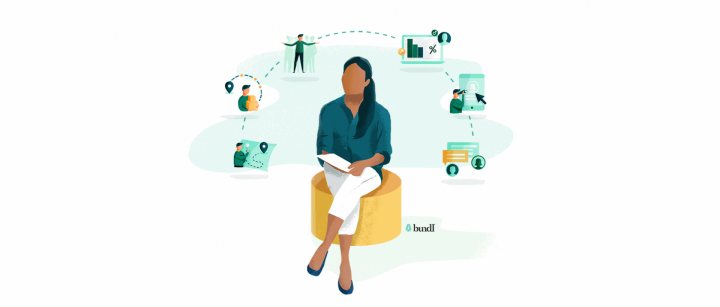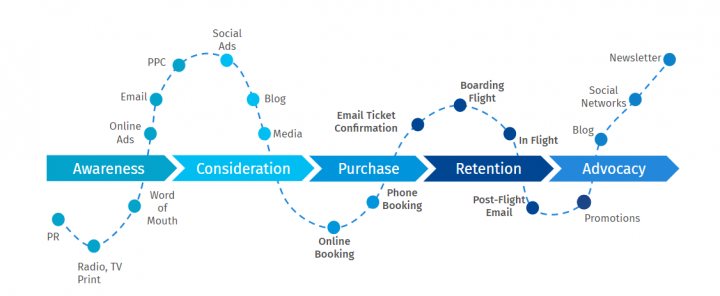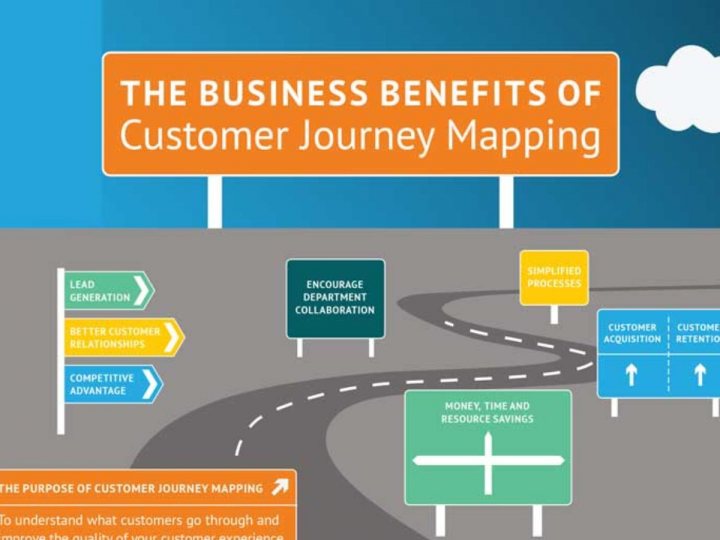
A customer can be defined as an individual that purchases goods or services. Customers are the core of every business idea, without which a business cannot continue to exist. They are vital as they drive revenue. The customer journey starts from a customer's realization that they have a want or need they want to meet.
Every business competes to attract customers' attention using different marketing channels available at their disposal. Customers are always looking for value; that is why companies ensure that they offer the best goods and services.
What is a customer journey?
A customer journey starts from the very beginning, even before a customer is aware that they need a particular product or service. A customer's journey starts from the awareness stage to the purchase stage. Every interaction a potential customer has with your brand affects the individual's perception of your brand.
It goes to a considerable extent of determining if they would look up to you when the need comes. The internet age has made it a lot easier for brands to subtly make an impression on potential customers before they attempt to make a purchase decision.
A customer journey covers all the experiences customers go through when they first hear about you up till they take the desired action. There are so many software tools out there that can help you create and manage customer journeys.
Create and manage your customer journey map

What is a customer journey map?
A customer journey map is a visual representation of a user's journey. It includes the steps, actions, and templates you use to determine your potential customer's journey. It explains the journey your customer takes while interacting with your brand. It represents how your customers interact with your brand ensuring that you monitor every touchpoint till they take a desired action.
Customer journey mapping helps businesses gain more insight into customer problems and develop better solutions to these pain points. Now you can improve a user's experience with your brand.
Identifying Customer Needs
To stay at the top, you must ensure that you have what it takes to get there and remain on the top. In business, your customers are at the foundation of all you do. They are the greatest determiners of the success of your business.
Customers can take you from zero to hero in a matter of hours, and trust me when I say they can take you back to ground zero in no time. In business, customer satisfaction is very important.
The first step to satisfying your customers is understanding them, doing market research, and identifying their needs. Creating services or products around customers' pain points is a great business idea because you are solving people's problems.
So how do you identify customers' needs? It is very simple. You can identify customers' needs through the following methods:
- Customer feedback
- Study competitors
- Social Listening
- Keyword Research
How to create a customer journey?

You can create your customer journey map in these easy steps.
1. Set your objectives: The first step towards mapping a customer journey map is to ask ourselves some important questions. Why are you making one? What is the goal of this map? Who is the target audience? What experience is the map based on?
With all this information, you can easily create your buyer persona. A buyer persona is a representation of your average customer based on their psychographics and demographics. All of this sets the direction of your customer journey.
2. Profile your customer personas and define each of their goals: The next thing on your agenda should be conducting research. Get customer feedback through user testing, questionnaires, and surveys. The most important thing is to reach out to people that have shown interest in your products or services. You can ask questions that give you more information about how customers interact with your brand.
3. Create target audience personas: Now that you have learned about various customer personas that relate with your brand, it is time to streamline. Yes, pick one or two customers and focus on them. If you want your customer journey map to be effective, you should not group too many customers. A customer journey map is designed to track the experience of a customer taking a specific journey with your brand.
When creating a customer journey map, it is best to pick your most common customer persona and consider the path they will take when engaging with your brand for the first time.
4. List all touchpoints: This refers to places on your websites where potential and existing customers can interact with your brand. List out all the touchpoints on your website. This is very important because it helps you know what actions your customers are taking. If they are not utilizing enough touchpoints, does it mean they are not interested in what you have to offer?
Well, whatever the reason is, highlighting these touchpoints help understand the goals of the customer journey.
When creating your journey map, consider the following touchpoints;
- Customer emotions: Emotion is the greatest motivation behind every action a customer takes. Customer emotions may change along the way; that is why you need the right content at each emotional touchpoint to make their journey smooth.
- Customer actions: Make a list of all actions customers are likely to take while interacting with your brand. Taking notes of the number of actions a customer needs to take before they can get to the end of their journey is very important. Are they too little or too much? You might need to make necessary adjustments.
- Customer pain points: Take note of any difficulties that customers encounter when interacting with your brand. Are your products or services within reach? Another common pain point is cost. Maybe the price of your products or services is off the charts; this can cause potential customers to leave no matter how much they are interested in your offer. Highlighting these pain points will help solve them while mapping your customer journey.
5. Identify available resources and what you will need: Take note of all available resources that you will need to create the perfect customer experience. Taking an inventory of available resources helps you spot any flaws and what you will need to improve the customer experience.
6. Test run the customer journey: Hold up a minute; you are not done with your customer journey map just yet. Make sure that you test run your customer journey. It would be best if you took note of people's activity on your website. What is the bounce rate? How can you improve user experience? You should be able to answer all these by the end of your map drafting.
All of this helps pinpoint where you need to make more effort. Now you can be sure that you provide the best experience for your customers and provide solutions to any issues they might encounter.
7. Make necessary adjustments: Now, you are almost done with your customer journey map. The results you get from your research and test run will give you an idea of what your website should look like. You can make much-needed adjustments to your website.
It could be more call-to-action buttons or clear product descriptions. With the help of your customer journey map, you can easily address customer needs and pain points.
Benefits of a customer journey map?

A customer journey map is one of the most effective tools for seeing how customers interact with your company and for comprehending their thoughts and feelings. Customer journey maps depict how a customer interacts with a company in a visual format. This journey map poses a lot of benefits for companies, some of which include:
-
Improved customer comprehension and pain points.
-
Enhance the customer experience.
-
Anticipate customer behavior.
-
Increase sales by predicting customer behavior.
-
Cost savings
A customer journey map allows you to optimize the journey of each customer that comes in contact with your brand. It is also a visual representation of the logical order of your customer journey.
Closing Remark
You can please your customers at every point of their buying process after thoroughly grasping their experience with your company. Customer pain spots, emotions, and your company's touchpoints and processes are all aspects that can influence this journey.
Whether you're optimizing your customer journey or investigating a new business opportunity to meet a client's unmet needs, a customer journey map is the most effective way to visualize this information. Start mapping out your company's future consumer success with the free templates in this post.
Request A Call Back
Ever find yourself stirring at your computer screen and a good media slogan to come to mind? Oftentimes.





